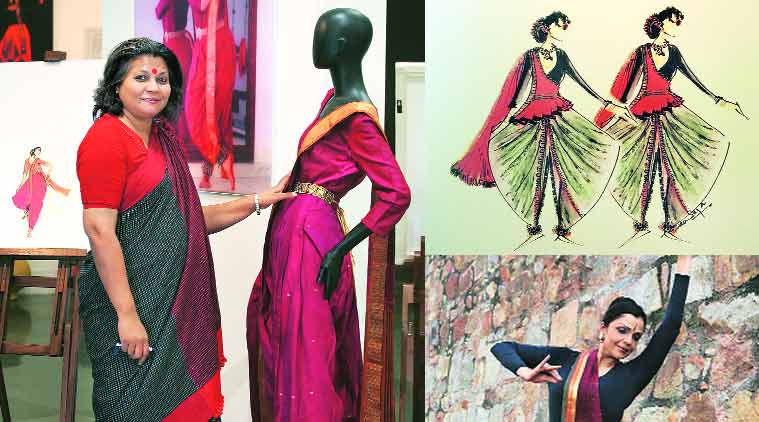Clothing the Form
A pink and gold Bharatanatyam costume caused quite a bit of furore almost two decades ago. Created for dancer Geeta Chandran’s Bharatanatyam piece, Shringara Vaibhavam, “a sensual celebration in which the nayika represented the longing for union with the universal male”, the costume was far from the traditional and “acceptable” Bharatanatyam costume — one with a pleated fan and the accordion pleats in the front. The front pallu placed on top of the blouse, which covered the breasts, had become many inches thinner and fell on one side of the shoulder, exposing one side of the torso — a blasphemy in an art form that originated in the temples of Tamil Nadu. “I wasn’t accentuating the breasts. The top wasn’t fitted. Why should one have this stereotypical thing of the melaaku covering the breasts. This was traditional and yet it was stylish and comfortable,” says 47-year-old costume designer Sandhya Raman, who wanted to express the sublimity of the dance and its rhythmic movement through the costume.
But the purists didn’t buy it. For them, she had let tradition slip. “I have nothing against the traditional costumes. I love them. But I love them on a slender figure. The body develops, and moves to a full-figured woman’s body and that’s when you have to re-look at the design. I have my reservations when a dancer turns or when you see the back. The fabric and the weave is so refined, then why be insensitive,” says Raman. The pink and gold costume is donned by a mannequin next to Chandran’s photograph dancing in it, alongside many other costumes and photographs which are on display at Indian International Centre as part of an exhibition titled “When the Pleats Dance”.

The Delhi-based designer has designed for many Indian classical dancers including Anita Ratnam, Aditi Mangaldas, Kishen Maharaj and Malavika Sarrukai, and for the last two decades has been busy giving this sartorial symbiosis a dramatic showcase. Before tweaking the costumes, Raman learnt Bharatanatyam, a form she trained in for almost four years as a teenage girl, followed by a fascination for stitching clothes for her dolls.
While Ratnam and Mangaldas work in the space of mixing the contemporary with the classical, Sarrukai and Chandran are traditional Bharatanatyam dancers, who have embraced the modern in their costumes. Raman’s client list also includes a host of young dancers who are open to trying the new. This, despite the fact that in India, dance-related looks are not so well-known to fashion followers. “The traditional costume is beautiful but it cuts away from the daily life. It can be traditional, yet a fashion statement. One can dance and probably go to an after party,” says Raman, who sits through the rehearsals, reads the scripts, watches how the artistes move, their turns, the freezes before sketching the costume; almost every time on a figurine that’s dancing.
Raman’s interest in costumes goes back to her NID days where she studied apparel and textile design. It was there that she came across Noel Barnard from the New York-based Battery Dance Company in the late 80s. “I was quite taken in by how she had used upholstery material for the prince and the king’s role in the ballet. There were a lot of simulations that could be done and it didn’t have to be a particular fabric that had to be used. I realised this could be done in India. Why always go to a tailor to get the costume stitched,” says Raman, who later also worked with Jonathan Hollander of the Battery Dance Company on some of his projects.
When entering the world of designing for dance, which did not really exist back then (people preferred to go to their local, trusted darzi), she saw concerts where more zari meant more opulence. “That insensitivity is what was happening. But they were not trained people. They didn’t know when to draw the line,” says Raman, whose latter process involves looking for the right fabric. Some productions allow her to get the fabric woven. “Every dancer wants to look slim on stage, so I always use visual tricks,” says Raman, who has also designed the costumes for Totanama, a film by Chandita Mukherjee, which won the President’s short fiction film award in 1991. But it was her work with dance exponent Mallika Sarabhai and Hollander, comprising a thematic fashion show where she used dancers instead of models, which had Raman realise that she belonged to dance. “Classical dance connects you to the heritage, the craftsmen and the weavers, which is what can really uplift the status of all three,” she says.
Tags:
—————
